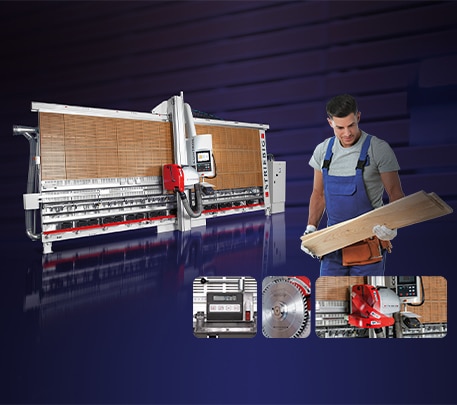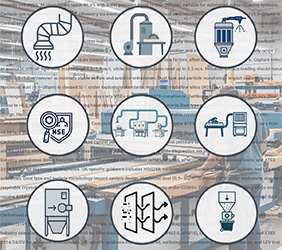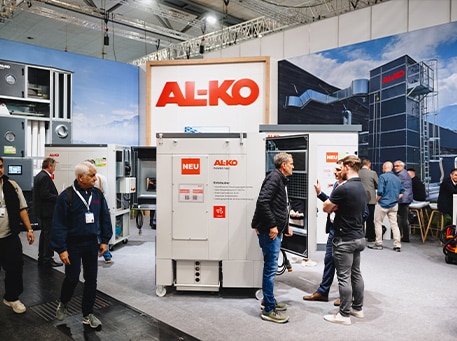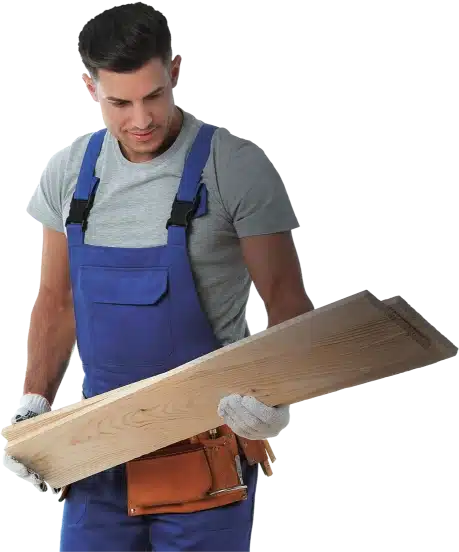With one of the highest accident rates in manufacturing, the woodworking industry is no stranger to the importance of meeting health and safety requirements. While machinery safety often takes the spotlight, dust extraction regulations are often less known.
The woodworking industry is moving from inherently safety focussed to one shining the spotlight on employee health and wellbeing. Understanding the legislation is the starting point, with many businesses going above and beyond statutory requirements to ensure the best woodworking environment for the team.
Where do I start with dust extraction regs?

There is a lot of confusion around legal requirements, and even the basics can feel like a real challenge, so we’ve put together some pointers to set you in the right direction.
Are there specific laws for safe wood dust extraction?
Specific regulations for dust extraction work alongside broader health and safety obligations and are designed to protect employees by reducing the risk of fire, explosion and long term and serious health conditions. Compliance with these regulations is non-negotiable and a responsibility you can’t afford to neglect.
What are my legal requirements as a woodworking business?
The Health and Safety Executive (HSE) provides many resources for understanding and implementing compliance measures. Staff training, risk management, monitoring employee health and keeping records are all part of your responsibility. It sounds complicated but with robust procedures and processes in place it’s easier to avoid costly mistakes.
How can I ensure compliance with dust extraction regulations?
Dust is a classified hazardous substance, so the most important legislation to comply with come under the COSHH regulations (Control of Substances Hazardous to Health Regulations). In summary, these regs are in place to ensure that everyone is protected from anything that presents a serious risk to health.
You are legally obligated to control any exposure to wood dust, assess the risks associated with it and put appropriate control measures in place. For woodworking businesses, this will include dust extraction systems with M class filters to minimise exposure and keep dust within defined safety limits.
Resources such as COSHH: the Safe collection of wood waste and COSHH and woodworkers – key messages set out practical guidance and examples risk assessments.
The importance of Dust extraction in protecting employee health

To understand the importance of monitoring employee health: the COSHH health surveillance page sets out the how’s and why’s and includes example risk assessments.
Is Local Exhaust Ventilation (LEV) a legal requirement?
Absolutely, and in the hierarchy of things that you must do to reduce risks in the workplace, this is the starting point.
Local exhaust ventilation is any system that removes airborne contaminants, and this includes dust. The priority here is making sure that your employees are protected from any air borne contaminants. In simple terms, the more efficient the extraction, the less requirement for additional measures such as protective equipment. And with employee safety the focus, it makes sense to install dust extraction systems with the highest and most efficient filtration, with inbuilt safety and monitoring features to build in real time assurance.
To comply with legal requirements, LEV systems must be appropriately designed, installed, and maintained. Regular expert inspections, air sample testing and workshop checks are all part of your legal duty. While it sounds complicated, a reputable supplier and installer that provides annual servicing and annual testing will make compliance straightforward.
What are acceptable wood dust levels?
Exceeding allowable dust exposure limits is a serious offense that could easily land you in court. The EH40 Workplace exposure limits to mixed wood dust were reduced from 5 milligrams per cubic metre to just 3 mg/m3 in 2020, and it’s a reasonable assumption that these limits could be increased to meet the more stringent 2 mg/m3 requirement in Europe.
If you haven’t reviewed your current dust extraction, making sure that you are not exceeding current limits is the starting point. Air sample testing is the only way to accurately measure your employees’ exposure to dust. Any sample that exceeds 10% of the upper limit will automatically trigger an action point for remedy. And the HSE are very clear that there is an expectation that your woodworking business should try to further reduce any exposure to dust particles, even when seemingly low.
While it sounds complicated, it’s straightforward. Air sampling conducted by a competent professional will keep you on the right side of legislation and help you maintain a healthy and safe environment.
What are the lowest workplace exposure limits achievable?
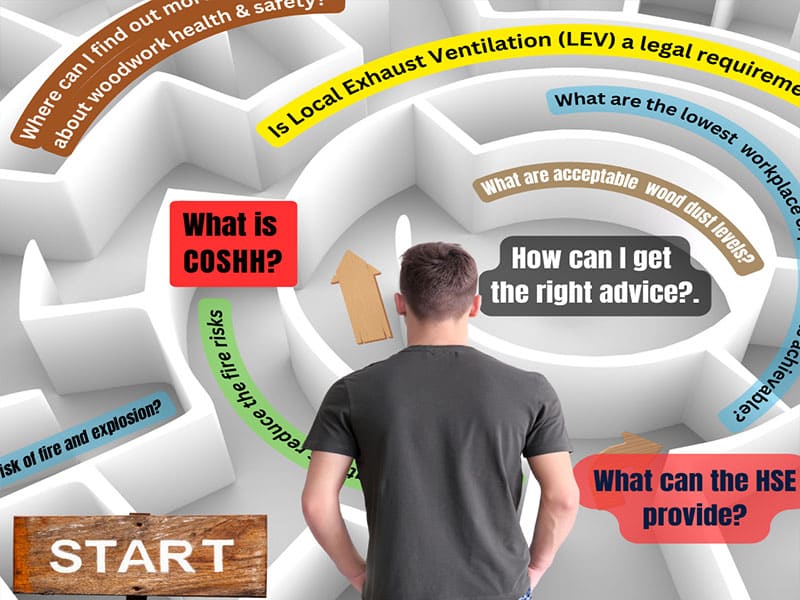
Achieving the lowest exposure rates requires several factors to work in tandem, including extraction, filtration and ducting. Leading brands like the German manufacturer AL-KO, are committed to developing highly advanced systems that push the boundaries. AL-KO’s Power Unit range, for instance, can achieve a staggering extraction rate of just 0.1mg/m3, resulting in the filtered air returned to the workplace that is up to 30 times cleaner than current required value in the UK.
Opting for the best dust extraction units doesn’t just bullet proof your safety obligations against future legislative changes – it prioritises health and safety.
Dust collection – what are the risks of fire and explosion?
Wood dust isn’t simply a fire hazard – incorrectly collected and handled, dust and swarf present a serious risk of explosion. Much depends on particle size distribution, moisture content, the source of potential ignition, ductwork and the position and the strength of the collection unit, so taking expert advice from a reputable supplier of high-quality dust extraction units is the safest route here, but understanding the how’s and whys is very important.
For practical guidance on how to reduce risks, it’s worth reading: the Safe collection of wood waste: Prevention of fire and explosion, published by the HSE.
How can I assess the risks of wood dust in the factory?
An important regulation to consider is the Dangerous Substances and Explosive Atmosphere Regulations (DSEAR), which provide specific obligations for handling dangerous substances, including dust. Reducing the risk of fire and explosion by Identifying risks, conducting regular assessments, and providing staff training and emergency plans are essential components of DSEAR compliance.
What safety features reduce the fire risks of dust extraction?
Classified as an ST1 combustible material, wood dust can generate enough power to cause a flash fire and could blow a machine apart. Lower dust levels inside the workshop results in higher dust levels inside and around the extractor – so additional safety features here, where the fire and explosion risk can be significant, make sense.
Advanced European technology makes it far easier to comply with UK regulations without the need for additional protective measures. German manufacturer AL-KO’s Power Unit range are shock resistant and pressure tested to contain any explosion. As a result, these can be safely sited inside the workshop without the need for more traditional explosion panel.
That’s the worst-case scenario covered, but what about additional features that protect your business? The Power Unit 250 is the starting point for models that include thermal sensors that shut down the fan when the temperature reaches 70°C and trigger an internal fire extinguishing unit when necessary. Higher safety standards by design, reduce the volume of additional measures and makes needed to comply with current UK regulations.
Where can I find out more about woodwork health & safety?
Is there an easy way to stay on top of dust extraction regulations and follow best practices? is a question often asked.
As the trade association for the woodworking and joinery manufacturing industry, the British Woodworking Federation is a great way to secure valuable support through publications, templates, training, and advice. While membership to the BWF is not mandatory, it does come with a health & safety manual and a H&S first response helpline, which can be a valuable go-to resource for forward thinking companies.
Latest news in the woodworking industry
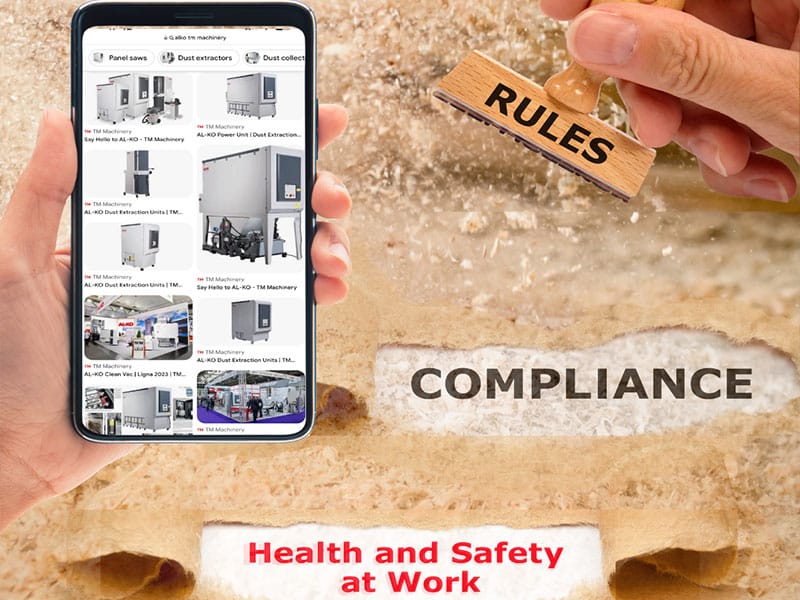
Whether you are small joinery team, or a large-scale furniture manufacturer, Furniture Journal, Woodworking News and Furniture & Joinery production are three leading titles worth adding to you reading list.
Dust extraction requirements – Getting the right advice
Getting to grips with the requirements of dust extraction can appear overwhelming, but it doesn’t need to be. In fact, it’s pretty simple: the main goal is to remove dust away from the operator and to do so as safely as possible. Air is going to be pumped back into the workshop, so you need to know how efficiently it filters dust and how well it protects from the risk of fire and explosion. And since woodworking is a naturally noisy environment, you need to consider the noise levels. All these factors are important when it comes to protecting your team.
However, getting the right advice can be harder. It’s easy for suppliers and installers to overcomplicate guidance by talking about ATEX zoning, UKEX, CE and EX, but a reputable professional will recommend the best dust extraction solutions, make light work of legal requirements, maintenance and air sampling, and save you from making expensive mistakes. If you are being bombarded by acronyms, it could be time to speak to another supplier.
Choosing the right supplier is going to get easier. A new Competency Register is on the cards for LEV specialists, making it easier to choose suppliers that can provide the right advice. To be launched by the British Occupational Hygiene Society (BOHS), the new Professional Standards Register (PSR) is anticipated that this regulation will be held to the same regard as Gas Safe engineers. Right now, BOSH qualifications are not mandatory, but they are a strong indicator that a supplier is invested in providing up to date and accurate advice.
Ready to find out more about the best dust extraction units for your business?
At TM Machinery, we have over 30 years of experience in the woodworking industry and work with you to ensure the highest levels of air quality and safety, with dust extraction solutions units that go-beyond the current UK legal requirements to future-proof your business and employee wellbeing.
Talk to us today for expert advice on how to optimise dust collection and improve health & safety for your business.
For the latest regulations: The Health and Safety Executive (HSE) is Britain’s national regulator for workplace health and safety. It prevents work-related death, injury and ill health through regulatory actions that range from influencing behaviours across whole industry sectors through to targeted interventions on individual businesses.
Contact Us Today
To find out more about our woodworking machinery range contact the team at TM Machinery.
